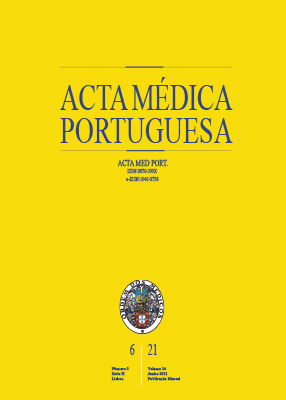Extracorporeal Membrane Oxygenation: The First 10 Years Experience of a Portuguese Pediatric Intensive Care Unit
DOI:
https://doi.org/10.20344/amp.15227Keywords:
Extracorporeal Membrane Oxygenation, Intensive Care Units, Pediatric, PortugalAbstract
Introduction: In Portugal, extracorporeal membrane oxygenation (ECMO) is used in pediatric patients since 2010. The aim of this study was to describe the clinical characteristics of patients, indications, complications and mortality associated with the use of ECMO during the first 10-years of experience in the Pediatric Intensive Care Unit located in Centro Hospitalar Universitário Lisboa Norte.
Material and Methods: Retrospective observational cohort study of all patients supported with ECMO in a Pediatric Intensive Care Unit, from the 1st of May 2010 up to 31st December 2019.
Results: Sixty-five patients were included: 37 neonatal (≤ 28 days of age) and 28 pediatric patients (> 28 days). In neonatal cases, congenital diaphragmatic hernia was the main reason for ECMO (40% of neonatal patients and 23% of total). Among pediatric patients, respiratory distress was the leading indication for ECMO (47% of total). The median length of ECMO support was 12 days. Clinical complications were more frequent than mechanical complications (65% vs 35%). Among clinical complications, access site bleeding was the most prevalent with 38% of cases. The overall patient survival was 68% at the time of discharge (65% for neonatal and 71% for pediatric cases), while the overall survival rate in Extracorporeal Life Support Organization registry was 61%. The number of ECMO runs has been increasing since 2011, even though in a non-linear way (three cases in 2010 to 11 cases in 2019).
Discussion: In the first 10 years we received patients from all over the country. Despite continuous technological developments, circuitrelated complications have a significant impact. The overall survival rate in the Pediatric Intensive Care Unit was not inferior to the one reported by the Extracorporeal Life Support Organization.
Conclusion: The overall survival of our Pediatric Intensive Care Unit is not inferior to one reported by other international centers. Our experience showed the efficacy of the ECMO technique in a Portuguese centre.
Downloads
Downloads
Published
How to Cite
Issue
Section
License
All the articles published in the AMP are open access and comply with the requirements of funding agencies or academic institutions. The AMP is governed by the terms of the Creative Commons ‘Attribution – Non-Commercial Use - (CC-BY-NC)’ license, regarding the use by third parties.
It is the author’s responsibility to obtain approval for the reproduction of figures, tables, etc. from other publications.
Upon acceptance of an article for publication, the authors will be asked to complete the ICMJE “Copyright Liability and Copyright Sharing Statement “(http://www.actamedicaportuguesa.com/info/AMP-NormasPublicacao.pdf) and the “Declaration of Potential Conflicts of Interest” (http:// www.icmje.org/conflicts-of-interest). An e-mail will be sent to the corresponding author to acknowledge receipt of the manuscript.
After publication, the authors are authorised to make their articles available in repositories of their institutions of origin, as long as they always mention where they were published and according to the Creative Commons license.









